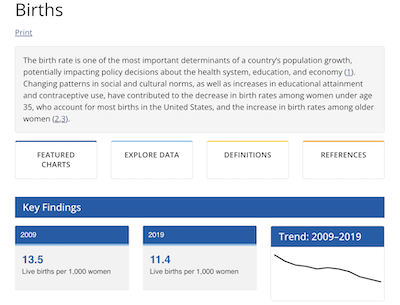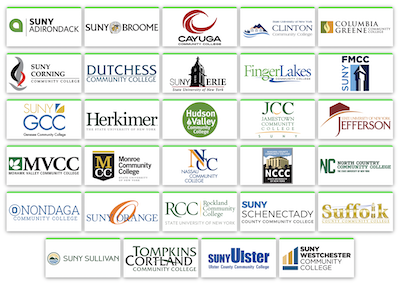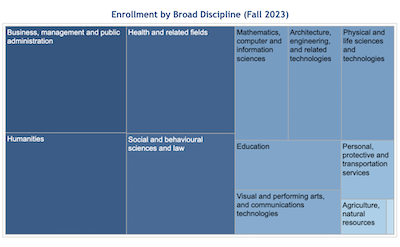Cynthia Eaton
Community colleges have long been referred to as democracy’s colleges. With origins reaching into the earliest years of the 20th century, the national need for community colleges was declared in the 1947 Truman Commission Report which, along with the post-WWII baby boom, contributed to their significant growth and expansion. Few states responded as thoroughly as New York. Even to this day, SUNY proudly notes on their website that “SUNY is embedded in virtually every community in New York State: Remarkably, 93 percent of New Yorkers live within 15 miles of a SUNY campus, and nearly 100 percent live within 30 miles.” That geographical proximity is enabled precisely because of our 30 community colleges, which directly translates into critical access for hundreds of thousands of citizens each year. While the mid-20th century baby boom expanded community colleges, new questions about the purpose and function of community colleges are coming at us fast, as we face what seems to be an ongoing baby bust, given the long-term decline in birthrates over the past decade. It is imperative, then, that we understand more clearly than ever who we are and what we do, so we can boldly answer the questions of where we are heading. When times are tough, we know that big thinking is necessary for lasting transformation that will keep our college healthy long into the future. Living up to our mission In the 2022 AAC&U book The Community's College: The Pursuit of Democracy, Economic Development, and Success, Robert Pura and Tara Parker argue that since Joliet Junior College in Illinois became the nation’s very first junior college in 1901, community colleges ever since have been tasked with promoting “the American ideals of democracy, opportunity, and social mobility.”
The SUNY Community Colleges’ own mission echoes this purpose: “the SUNY Community Colleges ensure open access to high quality postsecondary education and contribute significantly to the development of an educated citizenry and skilled workforce. ...All share a dedication to instruction and services that nurtures the academic and personal achievement of individuals with diverse backgrounds and aspirations.” The American Association of Community Colleges (AACC) Fast Facts 2023 notes that community colleges serve a more racially and otherwise diverse student body than four-year institutions. This has been true from the start. AACC’s history of community college page notes, for example, that in the early years, “a distinctive feature of the institutions was their accessibility to women, attributable to the leading role the colleges played in preparing ...teachers.” Nikki Edgecombe of the Community College Research Center adds that because community colleges “enroll a majority of undergraduate students from underrepresented racial and ethnic groups and from lower-income backgrounds,” we need to advocate for demography as opportunity. We need to live up to our mission: A representative democracy works best with a highly educated citizenry. In addition, we know that the median earnings of full-time employees holding an associate’s degree are considerably higher than those with a high school diploma or less, so community colleges remain a significant means for upward social mobility for a diverse range of students. Beyond vocational and transfer prep One purpose of community colleges was drafted in the middle of the last century as explained in SUNY at Sixty: The Promise of the State University of New York. “As envisioned,” writes Dennis Galloway, “the community colleges would do more than focus on technical education, they would also offer general education curricula leading to transfer to a four-year institution as well as specialized courses and education for part-time students.” Yet, as noted above, our roles are much larger than preparing students for transfer or to enter the local workforce. As Dante notes in his cover story, this is part of our role and the FA does advocate for more faculty in workforce-focused disciplines. However, this does not mean that we fail to comprehend the critical needs of members in our core academic disciplines, student support areas and beyond. The FA will continue to advocate for those as well—and we will continue to push for those lines to be filled with our adjunct colleagues (from January 1, 2014, to January 22, 2024, 58% of our full-time lines were filled by adjunct members, and we would not mind seeing that percentage increase!).
We know from SUNY’s own fall 2023 datasets that the humanities remain one of the two most highly enrolled areas in the statewide system at 15.2%, just a touch behind business, management and public administration (15.9%) and a bit ahead of health and related fields (14.4%) as well as social and behavioral sciences and the law (13.5%). Sort the data by community colleges alone, and the humanities leap to 34% of overall enrollment. Clearly, we must continue to advocate for the humanities and core collegiate support roles. While workforce-specific skills are valuable, no doubt, students and employers perennially turn to the humanities not only for the soft skills needed to improve our lives both in and out of work (we’re all familiar with the usual employer pleas for more soft skills; see The New York Times, Forbes, Business Insider) but also because they teach us what it means to be human. The humanities give primacy to learning for the sake of learning with an overarching purpose of creating more active, informed and engaged citizens. Again, democracy needs a fair and equitable society to thrive. Leading into the future According to 2021 AACC data, 41% of all undergraduates attend community colleges. Pura and Parker assert that “despite the demands on and the diversity of community colleges, they remain the least resourced and least funded institutions in the United States, calling our democracy and the purpose of our nation’s community colleges into question.” The FA’s New Deal for Students campaign is aimed squarely at collaborating with administration and other decision makers so SCCC has the resources needed to continue to live up to its goal of transforming student lives and strengthening democracy in our state. We remain the largest community college in the SUNY system and we were among the first in the state. Given our rich history as faculty who have helped to graduate over 140,000 students, we need everyone affiliated with the college, internally and externally, to come together and engage in the kinds of big thinking that will keep our students, our college and our county succeeding. |


